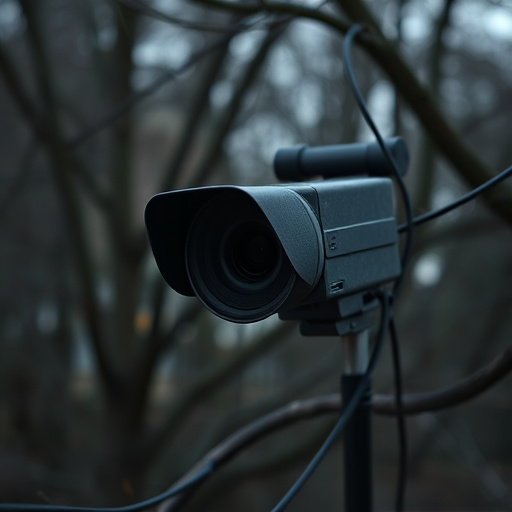Wireless Night Vision Security Cameras Indoors offer covert and efficient surveillance with IR technology, capturing clear images in darkness without external power or complex wiring. Discreet placement techniques include integrating cameras into decor, strategic positioning near windows and along walls, regular maintenance, and balancing comprehensive coverage with privacy rights while adhering to legal and ethical guidelines.
Uncover the art of discreet surveillance with our guide on wireless night vision camera placement. Learn how these advanced Wireless Night Vision Security Cameras Indoors can provide comprehensive coverage without compromising privacy. From understanding the technology to navigating ethical boundaries, this strategy guide offers insights for optimal positioning. Discover effective strategies to maximize indoor surveillance, ensuring both security and compliance with legal guidelines.
- Understanding Wireless Night Vision Cameras
- Choosing Discreet Placement Strategies
- Maximizing Indoor Surveillance Coverage
- Ethical Considerations and Legal Guidelines
Understanding Wireless Night Vision Cameras
Wireless Night Vision Security Cameras have revolutionized indoor surveillance, offering a covert and efficient solution for homeowners and businesses alike. These cameras utilize infrared (IR) technology to capture clear images in complete darkness, eliminating the need for external power sources or complex wiring. By integrating advanced image stabilization and low-light sensitivity features, they provide sharp and detailed footage even in challenging conditions.
The placement strategy for Wireless Night Vision Security Cameras indoors is crucial for optimal performance. Strategically positioning them near windows or areas with natural light during the day ensures ample IR illumination at night. Additionally, mounting cameras at a slight angle can help capture wider fields of view while minimizing blind spots. Discreet placement, often involving hiding the camera within everyday objects or using wall-mounted brackets, enhances their effectiveness as surveillance tools without drawing unnecessary attention.
Choosing Discreet Placement Strategies
When planning for concealed surveillance with wireless night vision security cameras indoors, discretion is key. Discreet placement strategies involve integrating camera units into existing decor or fixtures to avoid drawing unwanted attention. This may include mounting cameras behind artwork, inside false light switches, or even disguised as everyday household items like smoke detectors or fire alarms. The goal is to blend the technology seamlessly into the environment, making it nearly impossible for intruders to detect their presence.
For optimal results, consider placement that offers clear line-of-sight without compromising natural lighting. Wireless night vision cameras designed for indoor use often feature infrared (IR) illumination, allowing them to capture sharp images in low-light conditions. Strategically positioning these devices in corners or along walls can maximize their field of view while maintaining a low profile. Additionally, ensuring regular maintenance and testing ensures the system remains reliable, enhancing security without compromising privacy.
Maximizing Indoor Surveillance Coverage
To maximize indoor surveillance coverage with wireless night vision security cameras, strategic equipment placement is key. Positioning cameras at key intersections and high-traffic areas ensures comprehensive visibility. Mount them in a way that captures both horizontal and vertical views, avoiding blind spots. Utilize reflective surfaces like mirrors or windows to extend the camera’s field of view.
For optimal results with wireless night vision security cameras indoors, consider employing a combination of static and mobile cameras. Static cameras can cover fixed points while mobile units provide flexibility for dynamic situations. Ensure each camera is discreetly placed, avoiding obvious locations that might alert potential intruders, allowing for effective surveillance without compromising security.
Ethical Considerations and Legal Guidelines
When considering placement for wireless night vision security cameras indoors, it’s crucial to balance effective surveillance with ethical considerations and legal guidelines. The use of hidden or disguised recording equipment raises privacy concerns among individuals and organizations alike. It’s important to ensure that any camera placement respects the reasonable expectation of privacy as per case law and relevant legislation. For instance, in many jurisdictions, capturing images or audio of individuals without their knowledge in places where they have a legitimate expectation of privacy is illegal.
Specific regulations vary by region, but generally, cameras should not be placed in areas where individuals would reasonably expect privacy, such as bedrooms, bathrooms, or other personal spaces. Additionally, organizations must obtain consent for surveillance in common areas and inform employees or patrons that cameras are in operation. Awareness and transparency about the presence of wireless night vision security cameras indoors can help foster trust and mitigate potential legal issues.
Wireless night vision security cameras indoors have evolved as a discreet and effective surveillance solution. By understanding the capabilities of these cameras, strategically placing them, ensuring comprehensive indoor coverage, and adhering to ethical guidelines and legal standards, you can create an enhanced safety network for your space. The right equipment placement goes beyond just installation; it’s an art that combines technology with privacy respect, ultimately fostering a secure environment.
